How Do We Make This Work?
Furnishing Your Makerspace
Makerspaces are created for a wide variety of uses, ranging from STEM, STEAM, and other project-based learning environments, to places where communities can gather to share common resources, and work either independently or in groups. While the former may be more focused on specific activities, the other may need to accommodate a greater variety of activities. Regardless, a critical component to creating a successful makerspace is how it is furnished.
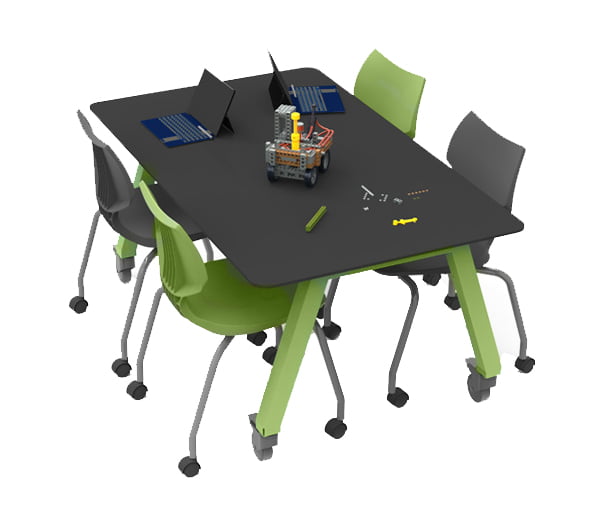 It’s not unusual for furnishings to be contemplated later in the design process; sometimes not until the construction is nearly complete. This is not beneficial as furnishings are being recognized as an integral piece of the design considerations necessary to support the function of and activities within the built environment. Getting the furniture right is just as critical as providing adequate lighting, acoustics, power, data, heating, and cooling. These factors, and many others, combine to create a properly functioning built environment – or not. As you begin to think through how you will be using your makerspace, think about what furnishings will be needed for these activities. Will there be a need to store lots of parts and pieces? How big or small are they? How often will they be accessed? Will people need to stand while working? How often, if at all, will the furniture need to be moved around for different activities? And the list goes on and on. To help you set off in the right direction, here are some general things to consider when planning your makerspace. Remember – a lot depends on the activities taking place.
It’s not unusual for furnishings to be contemplated later in the design process; sometimes not until the construction is nearly complete. This is not beneficial as furnishings are being recognized as an integral piece of the design considerations necessary to support the function of and activities within the built environment. Getting the furniture right is just as critical as providing adequate lighting, acoustics, power, data, heating, and cooling. These factors, and many others, combine to create a properly functioning built environment – or not. As you begin to think through how you will be using your makerspace, think about what furnishings will be needed for these activities. Will there be a need to store lots of parts and pieces? How big or small are they? How often will they be accessed? Will people need to stand while working? How often, if at all, will the furniture need to be moved around for different activities? And the list goes on and on. To help you set off in the right direction, here are some general things to consider when planning your makerspace. Remember – a lot depends on the activities taking place.
Seating
Seating is typically the first thing people consider, as having a comfortable place to sit is usually high on the list of priorities. There are numerous options to consider in selecting the right seating for your purposes.
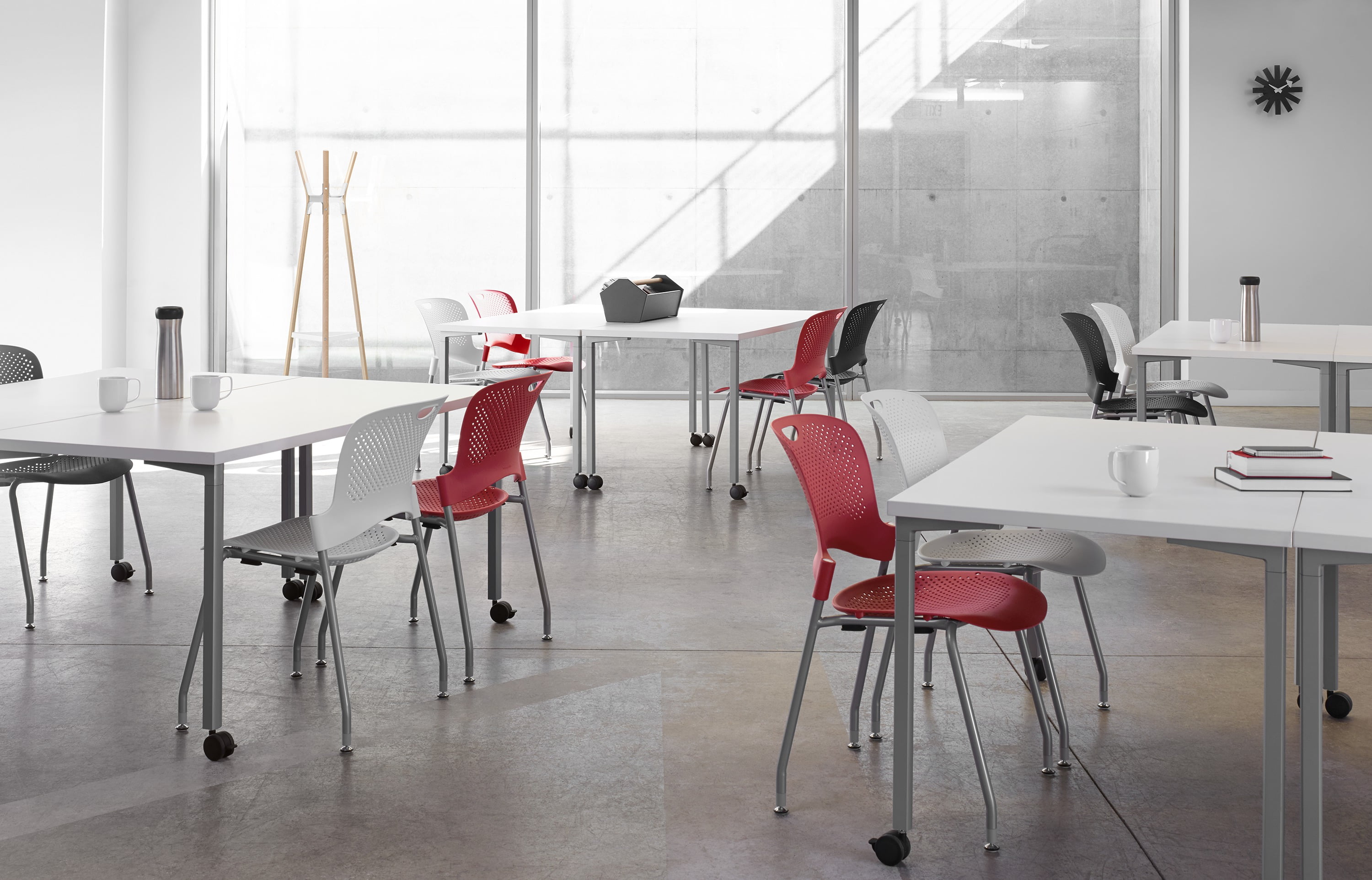 Upholstered, Mesh or “Hard Shell”?
Upholstered, Mesh or “Hard Shell”?
If your projects do not have a high risk of spills, stains, other means of damaging fabrics, upholstered seats can be more comfortable. Many non-upholstered chairs are designed to be much more comfortable than in the past. Polymer shells have become more flexible and some manufacturers have developed a means of connecting the shell to the base that allows for some movement of the shell as you change position in your seat. Contrary to popular belief, humans do not “sit still”, ever. And that is actually a very good thing. Non-upholstered chairs can also be easier to clean and do not need to be replaced as often since there is no upholstery to wear out (or go out of style). Chairs with mesh seats and backs are still common, but many manufacturers have returned to fabric upholstered seat cushions and mesh seat backs. While mesh seats offer “breathability”, they are difficult to clean and even more difficult to repair if torn or otherwise damaged. Dropping a utility knife or scissors could be a rather expensive slip-up.
Arms or Armless?
I generally would not recommend chairs with arms for makerspaces since they will most likely just get in the way. Depending on the table / chair combination, arms can prevent people from getting as close to the work surface as they might want to. Is there’s a lot of up-and-down activity, arms can make it more cumbersome to get in and out of the chair. High-activity spaces, such as nurse’s stations, usually do not have chairs with arms.
Casters or Glides?
Unless you anticipate a frequent need to move chairs around the space, you can most likely save the additional cost of chairs with casters. However, if you opt for glides you should consider the floor finish material being specified and select the appropriate type of glide: metal, polymer, or felt. Polymer glides are usually a good choice as they are acceptable for several flooring materials. Felt glides, while quieter when chairs are slid across the floor, can trap grit that will scratch the floor. The flooring material should also be considered when opting for casters. Light-weight chairs with casters go zipping across a hard floor quickly. Great if you’ve reconfigured the furniture layout; not so great if you bump the chair as you’re about to sit in it. Some manufacturers offer “breaking casters” that don’t roll as easily if no one is sitting in the chair. Once you sit, the casters roll easily.
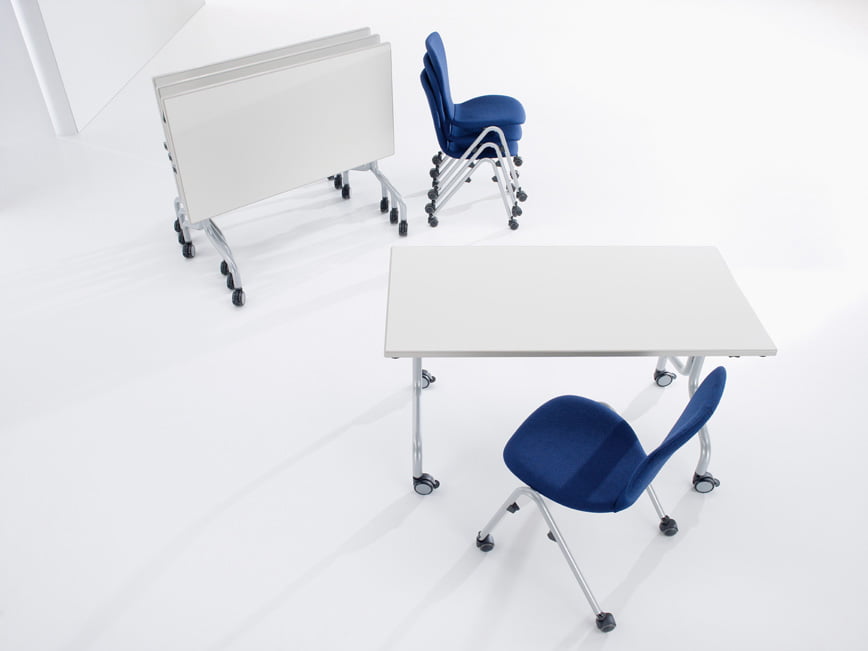 Stacking Chairs?
Stacking Chairs?
This question, more so than others, depends on how the space is used. If you anticipate the need to frequently “clear the floor” for robotics challenges, project testing or demonstrations, etc., stackers are a good idea. Nesting chairs are also an option but take up more floor space when stored.
Adjustable Height? What about Stools?
Since much of the above also applies to stools, the key question is: how long people will be sitting on them? For short durations (about an hour or so), a backless stool is okay. For longer durations, a stool with a back is recommended for comfort; a chair might be a better choice. For “tall” stools, a foot ring or integral footrest is a must. What about adjustable-height seating? If you have room in your budget, yes. They’re a bit more expensive than fixed-height seats, but well worth it if you will be serving a wide range of age groups.
A Final Word on Seating
It’s worth repeating the opening statement of this section: a comfortable place to sit is usually high on the list of priorities. As well it should be. If you’re uncomfortable, your focus is on the discomfort, not the activity you are participating in.
Work Surfaces
Work Surfaces are a little easier to deal with as there are fewer decisions to make when selecting them and, honestly, they’re not as critical to comfort as seating.
Height: Standing? Seated? Both?
Chair height all depends on the task at hand. Generally, seated height is more flexible in that it facilitates a variety of activities and is more likely to be grouped together, or “ganged”. Standing height is also good, but after a while people will usually want to sit. Adjustable-height tables are expensive, but if you see the need for them, a pneumatic lift mechanism is the best method. Tables that are adjusted by means of a set screw on each leg are less likely to be adjusted as needed. Depending on your needs, a combination of seated- and standing-height tables is a good option.
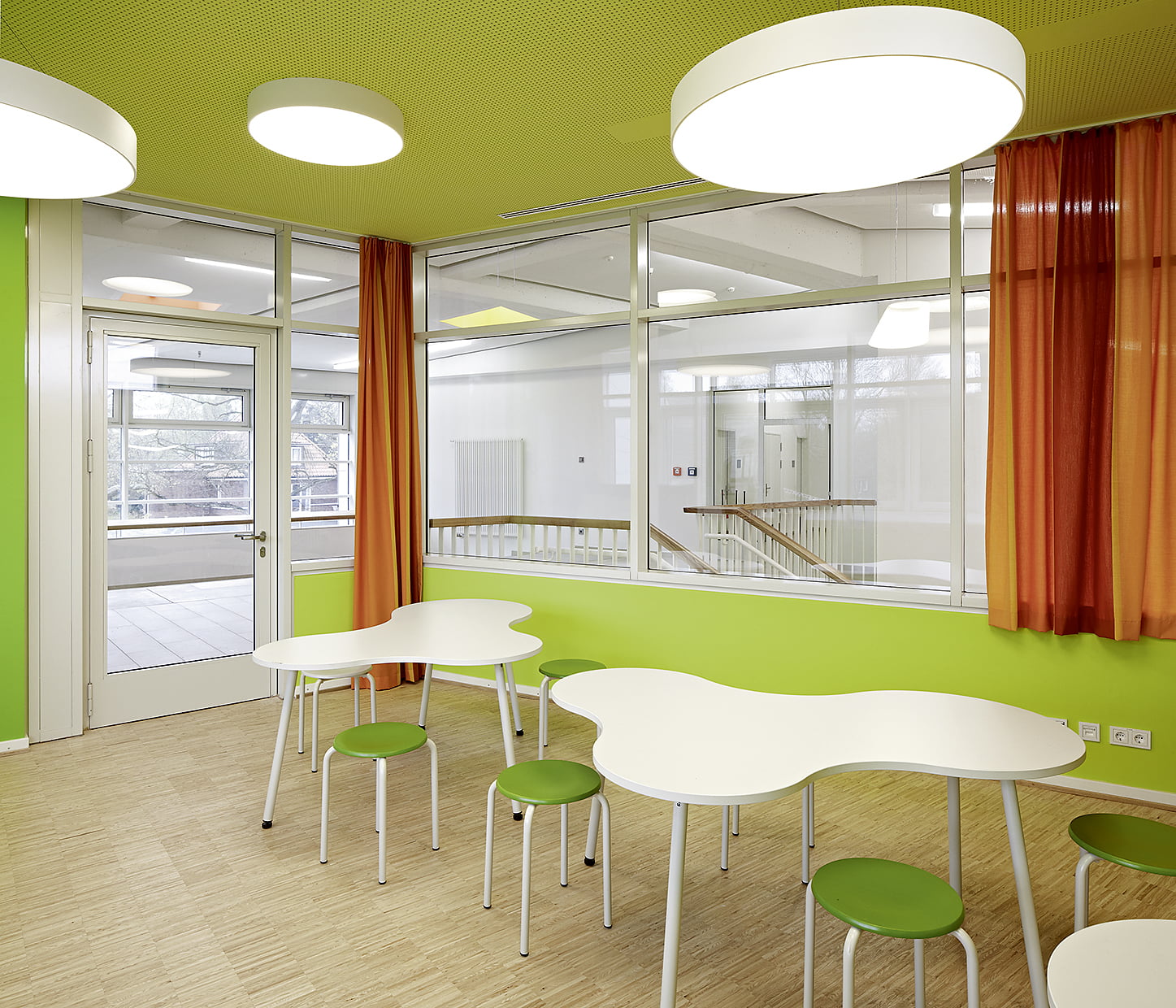
Shape and Material
In addition to round, rectangular, and square, tables are available with tops that are curved, triangular, or some variation of a rectangle. While curves, triangles and trapezoids are interesting, I find them to be less flexible than a basic square or rectangle. The latter are much easier to reconfigure in a number of different layouts, where the former can be limited to only a few configurations. Table edges have a similar issue. For ganging tables together, flat edges are best since they don’t create a gap of sorts between tables that curved, or “bullnose”, edge will.
For tabletop materials, plastic laminates are the most convenient and cost-effective. They’re durable and easy to clean. Wood or wood laminates can be scratched or otherwise marred. An exception to this is the wood butcher block tabletop. Yes, they can be marred, but are durable and have an interesting look to them.
Mobility
If you plan to reconfigure your makerspace frequently, casters – without question – are a must. Be sure that the casters are lockable so they don’t roll around when in place. An option that is becoming more common for smaller tables is the wheelbarrow configuration. Here, only two legs have casters. To move the table, simply pick up the end without casters and move it – like a wheelbarrow. If you expect there will be a need to move furniture to the sides and create open space, nesting tables are a good option. They have a top that are hinged to the frame and can be flipped up. The tables are then wheeled out of the way and nest together rather than stacking. They are much better than the typical folding table.
Storage
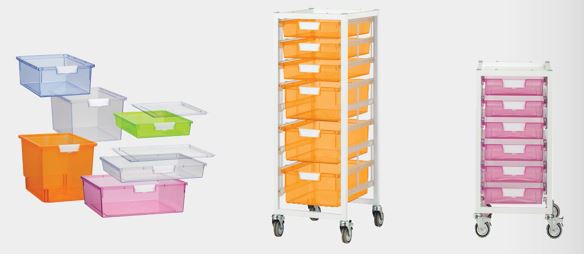 Makerspaces are for making. Making requires parts and pieces that need to be stored. The most flexible means of storing these parts and pieces will be carts. Fixed storage is very limiting because once they are built and put in place, they’re difficult – if not impossible – to reconfigure as your storage needs may change. Mobile carts are extremely flexible, having plastic bins that slide in and out of the cart frame and can even be removed from the cart. Bins are available in varying sizes and can be available with lids, inserts, and subdividers. There are some carts made specifically for makerspaces that can store larger sheets of paper and foam board, along with wood, tools and other maker essentials. Carts are mobile and easy to adapt as your needs change.
Makerspaces are for making. Making requires parts and pieces that need to be stored. The most flexible means of storing these parts and pieces will be carts. Fixed storage is very limiting because once they are built and put in place, they’re difficult – if not impossible – to reconfigure as your storage needs may change. Mobile carts are extremely flexible, having plastic bins that slide in and out of the cart frame and can even be removed from the cart. Bins are available in varying sizes and can be available with lids, inserts, and subdividers. There are some carts made specifically for makerspaces that can store larger sheets of paper and foam board, along with wood, tools and other maker essentials. Carts are mobile and easy to adapt as your needs change.
Wrap Up
Seating, work surfaces, and storage — these are just a few things to take into consideration when planning your makerspace. The one thing to remember is to plan ahead. Don’t wait until after your space is constructed to select the furnishings. You can’t predict every circumstance that may come down the road, but you can certainly plan for what you know and incorporate flexibility into your space.

